
Back in maybe second or third grade, circa 1987 at any rate, I was at school going through some old magazines in the classroom. I think it may have been art class and we were doing collages or something, but I honestly don’t remember. Just flipping through it until I spied car ads. Oh boy, car ads! It was a late ’60s Readers’ Digest, and out of all the advertisements contained therein, the best one was for the all new 1969 Grand Prix.
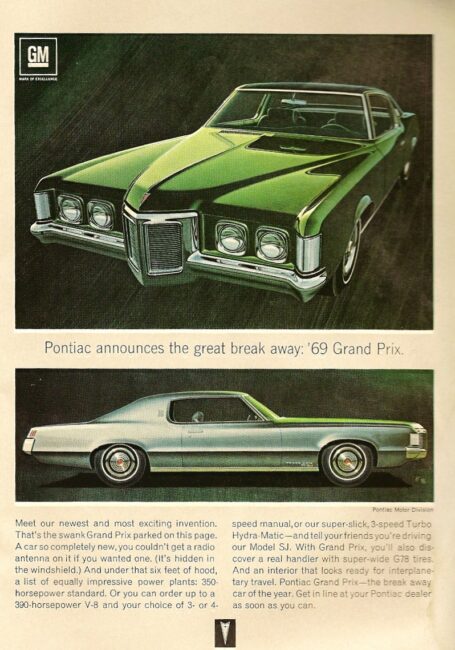
At least, I liked it enough that I carefully cut out the top picture from the magazine and kept it. It was pinned to a corkboard in my room for years. Odds are I still have it, somewhere in a drawer. Anyway, the above ad was the one, and the picture of the green car the one I finagled.
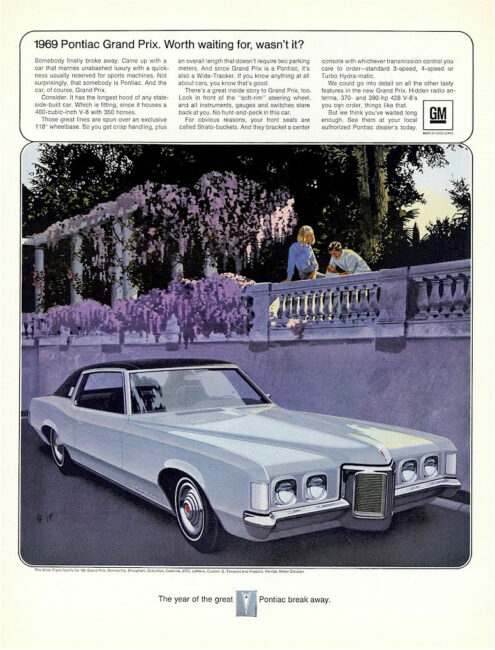
The 1969-72 Grand Prix breathed new life into the GP nameplate. Being based on the full-size Pontiac chassis since its introduction in 1962, in its last couple of years in that form, it lost some distinctiveness.
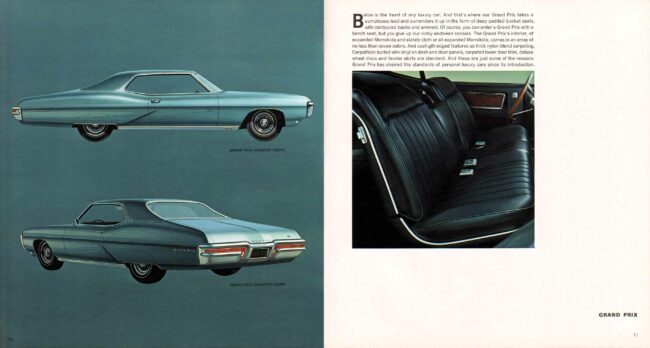
The ’68 in particular, despite being Henry Hill’s car in Goodfellas, looked an awful lot like a Bonneville or Catalina hardtop except for the hidden headlights and curved rear window. As I recall, one of the then-GM designers (can’t recall if it was Bill Mitchell or someone else) called the ’68 “…a big, fat turkey.” But that was all in the past with the debut of the all-new A-body derived ’69 Grand Prix.
Buyers responded as well, as sales jumped from 1968’s 31,711 to a very healthy 112,486 in 1969. They were lean and right with the times with their long-hood, short-deck body, up to the minute wraparound instrument panel, and huge option list. The Model J was the base model, with an upgraded “SJ” available with sportier overtones. The designations, of course, were a throwback to classic Duesenbergs.
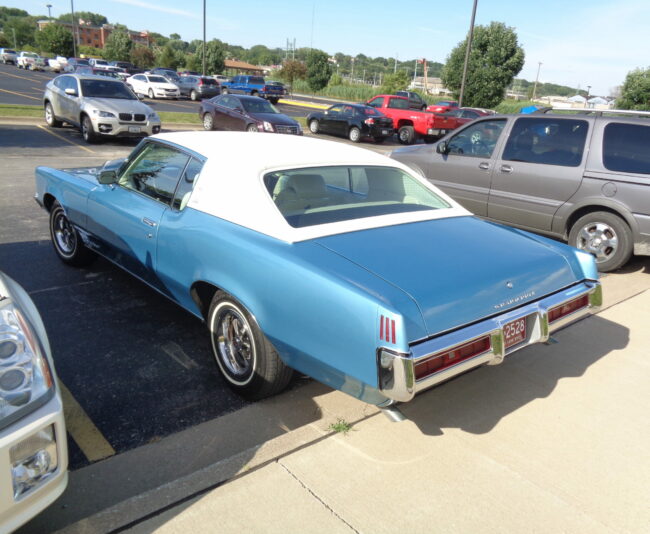
In addition to the year’s longest hood, all ’69 GPs had Strato Bucket seats, center console with floor shift, hidden wipers, hidden radio antenna and a V8 engine as standard equipment. Base price was $3866.

Base engine was a 400 CID V8 with 350 horsepower, with the top option being a 390-horse 428 with 465 ft lbs of torque. A two-barrel 400 with 265 horsepower was available, apparently as an ‘economy’ option.
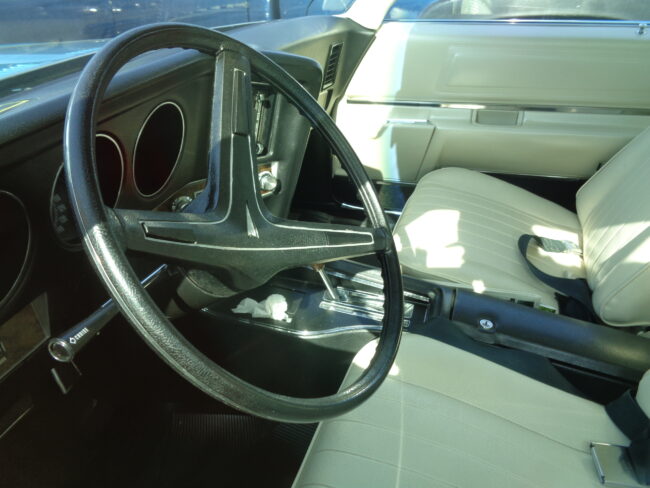
1970 models were much the same, with the exception of vertical grille bars, updated taillights and a newly-available leather interior.But really, it was so attractive that there was no need for drastic changes.
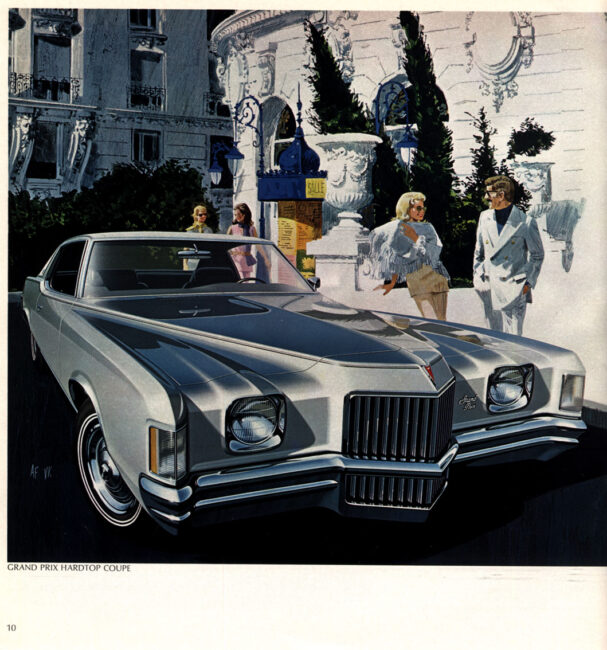
A more formal “neoclassical” facelift appeared in 1971; for ’72 a revised grille was the biggest change. 1973 saw an all new GP based on the new midsize ‘Colonnade’ body. Sales dropped to 65K in ’70 and 58K in ’71 (despite the revamped sheetmetal) but bumped up to over 91K in swan-song ’72. I’m sure the 1971 GM strike had something to do with that.
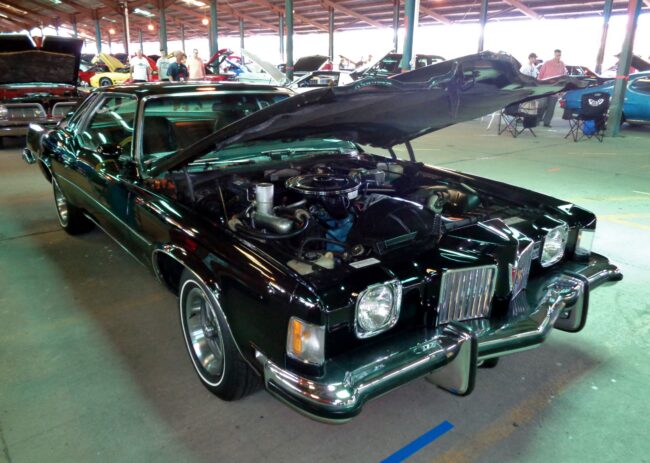
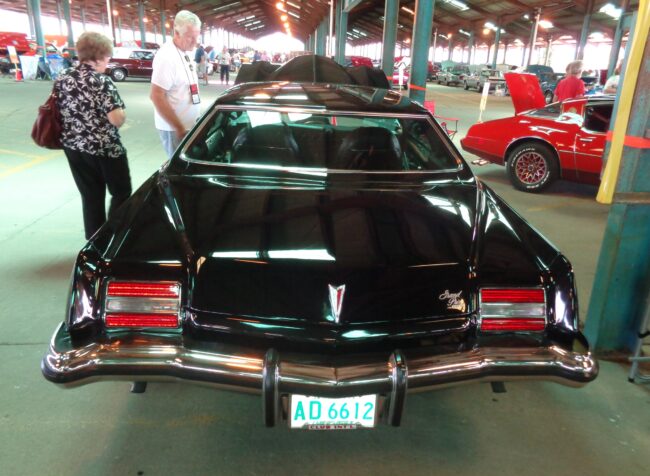
And since we’re on the subject, I need to mention that I like the Colonnade GPs too. While they may not have quite the same bold lines as the 1969-72, I still think they’re very sharp–especially the ’73 with its smaller bumpers and one-year-only tail.
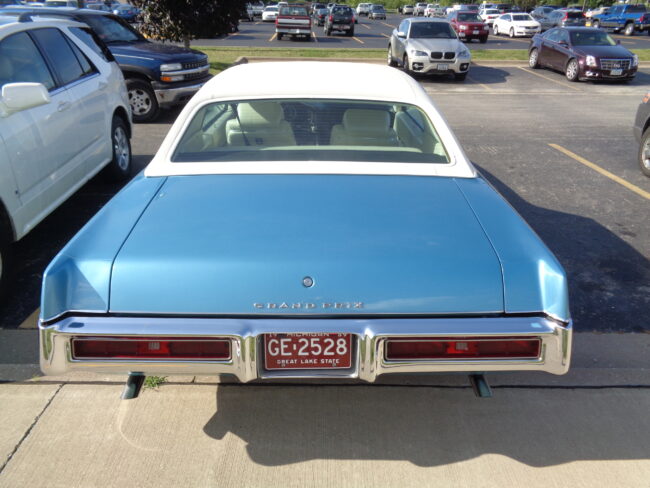
This one (and the black ’73 GP) was spotted at the POCI national meet, which ran July 14th through the 16th at the conveniently-close-to-your-author Isle of Capri casino in Bettendorf, Iowa. I went all three days. I conservatively estimate that I took 1,200 pictures, and one was this ’69 GP in what appears to be Warwick Blue with most excellent white top and white interior.
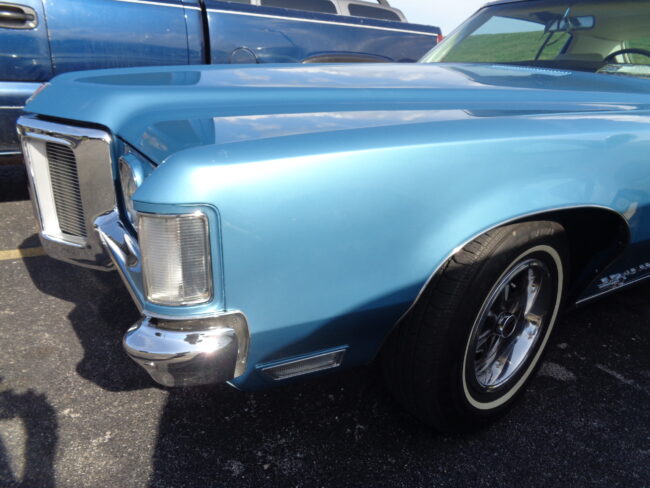
I’ve always liked blue cars with white trim, and probably should have taken more of this one. But there were so many sharp Pontiacs that it was total sensory overload. I think I meant to come back to this one for more shots, but several hours and several hundred pictures later, said thought was erased from my mind!
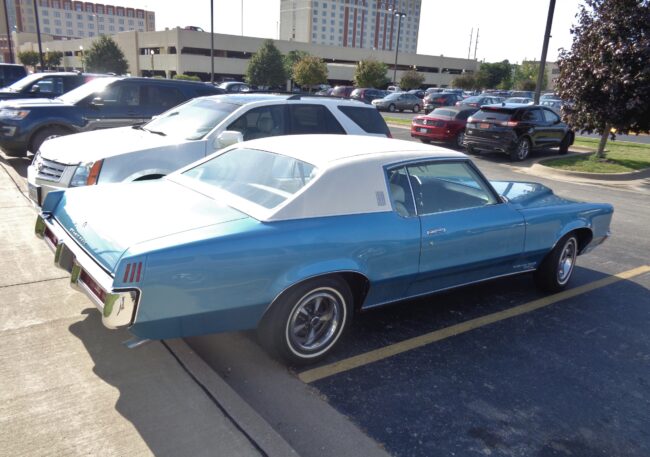








43 Comments
I really like the Pontiac ads of the period where one guy does an accurate painting of the car, while a second artist does the more impressionist background. There was was a TV show around then called “Night Gallery” that would start with an original painting as presenter and writer Rod Serling introduces the episodes gothic story. We have the series on DVD and have really enjoyed it.
Lovely 69 GP – Pontiac and DeLorean really did this one right. The mystery is why did GM even offer a 3 speed manual on such a car, and feature it in their ads? I can’t image any GP customer in 1969 actually wanting a 3 and the tree (with no synchromesh on 1st gear) mated to a 400 V-8, so why did GM and Detroit more broadly insist on keeping the 3 speed on the books as the standard transmission on their performance/status cars? Was it really worth the inventory cost, design cost, manufacturing, and manufacturing cost premium to offer an awful gearbox that 6 people would buy because they wanted to save $200 bucks versus the 4 speed manual or 3 speed automatic?
Stingray forgets one point although I compliment him on debasing a previous generation of Americans for both poor product planning for offering a combination he wouldn’t buy and making the bulk of buyers pay extra for the automatic, therefore guilty of money grubbing based on option cost, while on a car he half likes. He apparently does not remember that upper middle class American brands pre energy crisis were toying with the interesting engineering goal of maximizing fuel economy among their biggest engines.
This was done through gearing, pushing power lower into the rev range, and 2 barrel carbs on 400 cubic inch engines that were offered by Olds, Pontiac Ford, Chrysler and Buick on pre Arab 73 oil shock offerings, including as Tom stated this Grand Prix as a delete option. We understand that limiting high end power might make the owner just press harder on the gas, eating up the economy advantage. There is though the possibility of avoiding the hp deficit of the shlushbox automatic by ordering the three speed manual. That would establish a base line of what economy was possible while packing 7 liters. Wasn’t a 2 barrel 3 speed manual both faster and more economical than the more expensive base engine auto that almost everyone bought?
Stingray doesn’t care, because he left me alone pushing back against the Korean “Broughams” the Baruths are now full court pushing. When we think about how full of forethought our fathers were we realize how alone we are today pushing back against the stupid mob.
Instead of insulting me and putting words in my mouth that I didn’t say, perhaps you might consider providing some real facts to address my question. What portion of the 69 GP buyers went with the 3 speed manual – 1%, 2%? And assuming those 1% would have gone to some other showroom because of Pontiac’s decision to not offer a GP with a 3 on the tree, what do you think the costs would be to achieve those 1% in “extra” sales in terms of engineering, product testing, and manufacturing time needed to engineer the chassis to take the 3 speed, train assembly line workers to install an extra transmission variant, and carry inventory in the manufacturing plants and spare parts warehouses for the extra transmission variant and all other 3 speed unique parts (i.e. shift linkages, clutches, gearshift knobs)?
Furthermore, do you really think a lot of economy buyers looking to save money would be looking at a relatively expensive and impractical GP instead of a base Tempest or Nova with a 6 cylinder or small V-8 to go with the 3 on the tree? As for “economy” 400 cubic inch engines, I believe they were mainly targeting buyers who didn’t want to pay for premium fuel rather than a serious effort to improve mpg in an era when regular was 25 cents per gallon and premium was 32 cents. And please educate me with the engineering principles that demonstrate how a 3 speed manual with 2 useful gears provides better “gearing” or power and economy than a 4 speed manual with 4 useful gears.
GM was doing a lot of things correctly in 1969 and making a lot of great cars as a consequence, but offering needlessly complex product options that few people bought and which were counterproductive to the desired image of the brand were not among them.
Maybe you guys should just challenge each other to a duel and be done with it.
Offering a few three speeds would have cost very little because it was a standard line wide production piece that of course would easily bolt up and also help make possible the performance 4 speed by having clutches that could be shared.
As far as who might buy a economy tuned 400 in a stylish Grand Prix. I would point again to how a powerful 3speed 400 might well beat a standard version 4 barrel automatic, there really was a lot of slush in the large engine automatic. For example a traveling salesman might enjoy this while achieving better highway miles than say a powerglide small block or even bigger carb OHC 6 in a Tempest/LeMans.
Remember also this is golden years GM when there was the resources to build something just to see how it would work. Long ago and far away, I understand.
Have you ever driven a 3 on the tree with no synchromesh 1st gear? Usually they have a stump puller 1st gear that is good for about 5 mph, before you have to use the slow, sloppy gear lever to move into 2nd where there will either be a huge gap that takes you off peak torque RPM, or there will be a huge gap between 2nd and 3rd when you use the slow sloppy gear lever to move into top gear – no way it would beat a turbo-hydramatic 3 speed of the era which was noted at the time as being near as quick at a well driven 4 speed manual when mated to one of the stronger Pontiac motors. Pontiac was not using Powerglides in 1969, so that was not the competition, and traveling salesmen did not drive GPs with a big motor and a 3 on the tree.
Rather than waste their dominant resources on providing 3 GP buyers with a 3 on the tree, GM might have spent the money instead on creating a 5 speed manual, or 4 speed OD automatic, or fuel injection that would allowed them to keep the big motors that buyers loved and still get reasonable fuel economy, or in better rust proofing or independent rear suspensions that would have allowed them to fend off the European and Japanese competitors. Stupid decision making and complacency is why GM went from making beautiful well engineered cars like the 69 GP to awful Chevettes, Olds Diesels, and other crap less than 10 years later.
Let me chime in on this 3 speed thing….
Because the car was basically a LeMans with a few inches grafted to the front of the chassis, I imagine it didn’t cost anything to offer a 3 speed in the Grand Prix, though I’ve never seen one.
Since the Grand Prix had pretty much the same 400 that came in the base GTO I’ll assume they used the same Dearborn Ford made heavy duty 3 speed manual with the floor shift, no column mounted 3 speeds in the GTO this vintage.
The z-bar, swing pedals, shift assembly was all out of the GTO, I’ve seen 3 speed GTO’s, a friend of mine has one, he converted it to 4 speed, it was a low option car, AM radio and full wheel covers were the only option.
Thanks for the insight Carmine, but it only makes the mystery even greater. Rather than make GM’s own Muncie 4 speed manual the standard gearbox, they bought 3 speeds from Ford to offer as the base transmission that no one would buy anyway on an upscale sport/luxury car. Now it all makes perfect sense, the only remaining mystery is why Cadillac didn’t offer the Ford transmission as the base on their Fleetwoods.
It was basically a direct swap with what came in a base GTO, it didn’t cost anything to offer it.
I know its fun to Monday morning quarterback decisions from 53 years ago but this is still a Pontiac, one notch up from a Chevrolet, the Grand Prix is an “upscale sports luxury” car on paper like, really its few hondos more than a LeMans and GTO, its not a $6000 Cadillac……it didn’t come with a 4 speed, it also didn’t come with a/c power windows, an RCA Color TV, a food processor or an ice maker.
69-70 is about the tail end of the 3 speed base transmission in cars above the low price Chevy-Ford-Plymouth field and by 1973 it was even gone from base full size cars pretty much, Pontiac, Olds and Buick dropped them out of their fullsize cars by 1971 or so though it hug on in stuff like the Nova’s until 1979.
I also want to add that the 3 speed in the GTO and GP was snycho in ALL gears.
Stingray, you bring up some great points and I really enjoy reading your posts.
I’m guessing the main point behind the three speed and 2 bbl was a lower price to get people into the dealership and to run ads in magazines, “Pontiac ____, starting at $3999.99” or whatever. And the salesmen would do their best to upsell to the more expensive transmission and powerplant/carb, along with everything else. “For only $275, I can put you into a 4 speed, 4 bbl…”.
Thanks David, and you might be right about trying to hit a certain price level with the 3 speed. I would argue they could have done it much more efficiently by making the Sprint OHC 6 with 4 speed manual the 3999 special, which would have been more in keeping with the euro-GT vibe of the 1969 GP, and been an easy upsell to the big V-8 power that most buyers wanted back then.
My dear old Dad had a a Dodge Coronet with a three on the tree and a super torquey little V8. I loved that car nearly enough to overcome my mother’s hatred of it. Super fun for a 16 year old. I don’t remember 1st gear being a stump puller, but I was clueless.
The stump pulling is dependent on the rear axle ratio – if you have a “highway” numerically low rear axle the 1st gear ratio might be useful, but if you have a “truck” or “drag strip” numerically high ratio the 1st year on a 3 speed is almost always a stump puller only useful for getting off the line with minimal clutch slip. 3 speeds are not necessarily bad, but I’ve never driven one that is as nice to use as a 4 to 6 speed – more gears and floor shifts are always better than fewer gears and column shift when it comes to fun and staying in the power band.
Having driven a 3 speed 1968 GTO with the same driveline that a 3 speed Grand Prix would have had on several occasions, it was perfectly fine to drive, the ratios were nicely spaced out, the car in general was kinda fun in a brutal way, it was a no power steering or power brake car, a mans machine.
Manuals in any 69-72 Grand Prix are pretty rare, even the 4 speed, the TH400 was the overwhelmingly popular choice, the automatic even had a racheting shifter built into the automatic, replacing the Hurst his/hers option.
Even the 4spd was a delete option.
I’ve owned 2 of them.
Mr. Klockau, thank you very much for this post. I have been a fan of this vintage of PGP most of my life. I think the 1972 was the high water mark for styling with the clean, elegant front and rear styling. Shade of 2nd Gen Camaro.
My second car was the 1973 model SJ with the 455 engine. I bought it from a neighbor who had purchased it new to tow an elegant horse trailer. People have forgotten that such cars were used for towing and it would be many years before pickup trucks offered the combination of muscle and luxury to adequately replace cars in this role. The original owner of my GP/SJ dumped it due to the spike in gasoline prices during the first Arab oil embargo. Having few other expenses and not driving very many miles per year I could tolerate the fuel cost and it proved to be short lived anyway. Those cars were very good in terms of ride, comfort and handling and in some respects I don’t think modern cars have appreciably moved the bar in these metrics. If I had Jay Leno’s resources I would have a lot of fun doing an LSX/6L80 swap and some chassis tuning on a 1972 or 1973. I’d keep the 8-track.
-Scott
You know, looking at the 1st ad. No vinyl roof. Granted it was 40+ years ago, but I’m not sure I ever saw one from that vintage without one. Must have. I did an online image search and there are some images of metal roofs. I think it looks great without vinyl. I’d like to think my 13-14 year old self would have noticed and remembered that.
I’m guessing the designer pushed for making the car available the way it was meant to be. Putting a vinyl top on this car takes it from being one of GM’s best looking coupes to being an awkward period piece from a time when Dodge would sell you an all-time classic in the same niche.
I’ve seen a couple ‘slick top’ 1969-70 GPs and they do look good. Maybe tonight I’ll go through my photo files and if I find one I’ll do a short post.
The Charger? Its a Coronet with hidden headlights and a tunnel roof, and lots of them had viny tops too…..
And the ten grand that will buy you a local-car-show-worthy ’69 Grand Prix won’t buy you a rusty firewall and a title for a Charger. Also, the vinyl top on the Charger looks like it may have been part of the original design sketches, while the vinyl top on a Grand Prix looks like it was applied in the dark behind the dealership by the car-wash boy.
Well them Duke Boys did a lot of Charger killing too……
The Charger is overvalued, like many Mopars are, the “its worth alot” argument only goes far with people that care about that.
I wouldn’t take one for free, other than to resell it to a sucker and buy something better.
You can get a Charger with an engine and a complete firewall for around $20,000, or less.
However many Chargers died for TV ratings, there are 24 ’68-’70 Chargers on ebay being actively bid to prices higher than the highest bid placed on any of the 8 ’69-’72 Grands Prix currently up for sale. The highest active bid for a GP is $5,001. It’s for a very nice and usable car. Meanwhile, here is the Charger you can buy for the price of that creampuff GP: https://www.ebay.com/itm/1968-Dodge-Charger/265004494866?hash=item3db37fb012:g:4G8AAOSwEW9f9mHe
It’s hard to blame scarcity when there are three times as many Chargers to go around, mostly because they’re in such demand that people are digging them out of the ground. You might not like the Coronet, but GM never built an intermediate that measured up to Chrysler’s.
Here’s a $65,000 Grand Prix SJ
https://www.hemmings.com/classifieds/cars-for-sale/pontiac/grand-prix-sj/2456255.html
So they’re not all completely worthless $5000 junkers.
I’m not sure where you get your info from but GM ABSOLUTELY DOMINATED the mid size car segment during this era and for years after, GM mid size cars are better in every measurable category, so I’m not sure what you’re talking about but you do like to argue so I’m sure you will, and you really get dug in like John C……
The Charger is a good looking car, I’m not taking that away from it was a good looking car in an era where every car was good looking, hooray, they got it right once, but its really a 1965-1966 car released in 1968 a tad behind the curve being set by market leaders like GM that had already moved to the curvier 66 Riviera and Toronado inspired styling.
That $65K is a fantastical asking price. I’m talking about actual(or shill) bids from buyers. I can put a $65K asking price on the broken bicycles in my parents’ basement, and pay for a national listing in the hope that someone will be nostalgic for a Murray Baja or a Rockhopper. That’s not the same thing as waiting to see the person willing to pay more than five grand for my junk gets outbid. The $5,000 Grand Prix isn’t a junker, by the way. It is nicer than a typical four year old GM used car.
Other than sales volume, I have no idea what makes you think GM had a measurable advantage in any metric for intermediates. Chrysler had engines, transmissions, suspensions, and styling. Fit and finish? Not often, but plenty of GM cars were built by commie kool-aid drinkers as acts of class warfare, so you’d might as well buy a car that’s worthwhile once you address its manufacturing shortcomings.
BTW, I guess we should all be writing gm in lower case now. Their Chinese masters must have thought it would be funny to neuter the logo.
So all your prices on Chargers are real and the price I posted for a Grand Prix is fake, I get it, I think I know how this works sort of…..as I said, you and John C do like to argue……even if it makes no sense at all.
“Chrysler had engines, transmissions, suspensions, and styling. Fit and finish?”
Yeah and I think all those are better on GM cars, again, its an opinion, we can agree to disagree and you know what they say about opinions and assholes….. this site is full of both……
I mean there has to be a reason that in decade from the time this Grand Prix came out GM was still selling mid size cars to retail customers and Chrysler was teetering on the verge of bankruptcy and selling Rosco P Coltraine fleet cop cars to keep the lines moving……
The prices I supplied are bid prices from buyers. The $65K price you used as evidence is an asking price from a hopeful seller, who hedged it with, ‘or best offer’ anyway. I could have listed the asking prices for completed Chargers, but they’re just asking prices. The lowest asking price for a beater Charger is $25K. The highest for a completed car is $298K. Cars that don’t need serious work start around $50K. Meanwhile, the highest bid on a GP is $5,001 and the highest bid on a Charger is $40,100. The GP is a useable car. The $40,100 bid Charger is a stalled project that needs many tens of thousands of dollars in bodywork alone. It’s also just a 440/automatic car from the least desirable 1970 model year, so it isn’t like the end result will be a Hemi/4speed Daytona.
https://www.ebay.com/itm/1970-Charger/164627965614?hash=item26549766ae:g:ffQAAOSw5clf9RPT
Why am I being drug into this one. I have no opinion on the relative value of the General Lee, may he rest in peace. and the Grand Prix in the classic car market. For 69 PLCs I am more Eldo, vinyl is fine, Corniche FHC no vinyl please, and glamour Bird, no vinyl.
BTW Why did the Chrysler bother offering a Slant 6 and 3 speed manual in the base Charger?
I can show you an auction result for a $750K 1969 GTO convertible too, really the GTO is the car the Charger sort of competes with better, but again, it could have come with the puzzling 3 speed Slant 6 combo instead of Chrysler just offering fuel injected Hemis and 6 speeds for everyone standard……
The Plymouth GTX was the Pontiac GTO competitor from Chrysler. They were all high performance and high equipment level cars. The Plymouth Road Runner and Dodge Coronet Super Bee were meant to undercut the GTO, but then Pontiac attempted to compete with those two using the Judge. Unfortunately, gm couldn’t compete with the performance of the Road Runner without driving the price of the GTO up rather than down.
The Charger had far more in common with the GP, being a coupe with some unique bodywork. The 1966 Charger was very much a personal luxury car; with a standard full length console, full instrumentation, nice seats, a big standard V8(361 ci IIRC), and some attention to assembly. Of course marketers couldn’t resist ‘broadening its appeal,’ by turning it into a typical Detroit empty vessel with an option list.
I wouldn’t argue in favor of a slant six Charger any more than I would any of the cars Detroit brands made when their competition was from across town. I do think the ’68 Charger was a beautiful car, while a ’69 Grand Prix with a vinyl top has many an awkward angle. You came in to argue against my view that the Charger had timeless styling while the Grand Prix became a fashion victim due to fake carriage roofs, and then you have the shameless lack of self-awareness and dignity to suggest that I like to argue for arguments’ sake. However little you think of me or John C, you really hate yourself.
And then you get nasty to satisfy your obliviously overinflated ego and to make up for your lack of character…..
See we can both do that too….
All I’ll say is while I like 1960s-1970s Mopars, Chrysler Corporation stumbled from one crisis to another between 1957 and the late ’70s. Heck, even in 1970, which may have been Peak Muscle Car, High Impact Challengers, 440 Six Pack Barracuda Gran Coupes and winged Road Runners, they were in the middle of a giant cluster. Doesn’t stop me from liking Chargers or GPs…though if we’re talking Highland Park I’d rather have an Imperial coupe or New Yorker…
I don’t dislike Chryslers, their tied with Ford as my 2nd favorite American automaker. I had a 77 New Yorker Brougham for several years, it was a great car, probably the best $400 car that ever existed, but inside you can tell where they cut corners, it was like a fully broughamed Bluesmobile.
The Charger is certainly a handsome car, from an era where it was hard to find an ugly domestic car, but I think the Grand Prix is a better car overall.
Beautiful cars from my childhood. Love the Van and Fitz ads, too!
By the time I was old enough to drive, the second Energy Crisis had occurred and these cars were less than desirable due to fuel mileage. I would love to time travel back to 1979 with a dumpster of cash and buy up all of cars like these. Oh well…
Yea, if only I had had $10k laying around during the 1974 or 1979 energy crises (and had a driver’s license and garage), I could have picked several 8-10 mpg Hemi/440 Mopars, big block SS Chevys, Super Duty Pontiacs, etc. that people couldn’t give away when gas rocketed past 50 cents per gallon and high octane premium disappeared. Way more fun way to achieve millionaire status than using the $10K to buy an S&P500 index fund.
I’ve hear and read all sorts of crazy stories of people trading in Mustang Mach 1’s for Pintos and Chevelle SS’s for Vegas and Rabbits.
my older brother had a green pontiac grand prix, with 4 front headlights like that: it may have been a ’69? I recall it had a white vinyl top
I was very proud when he’d give me a lift to school in it. It was fast & he used to race it on backroads with the other musclecar toting teenagers of the day. Eventually he wrapped it around a tree.
how much did they weigh?
3860 pounds base 3 speed 400 4 barrel
thanks John!